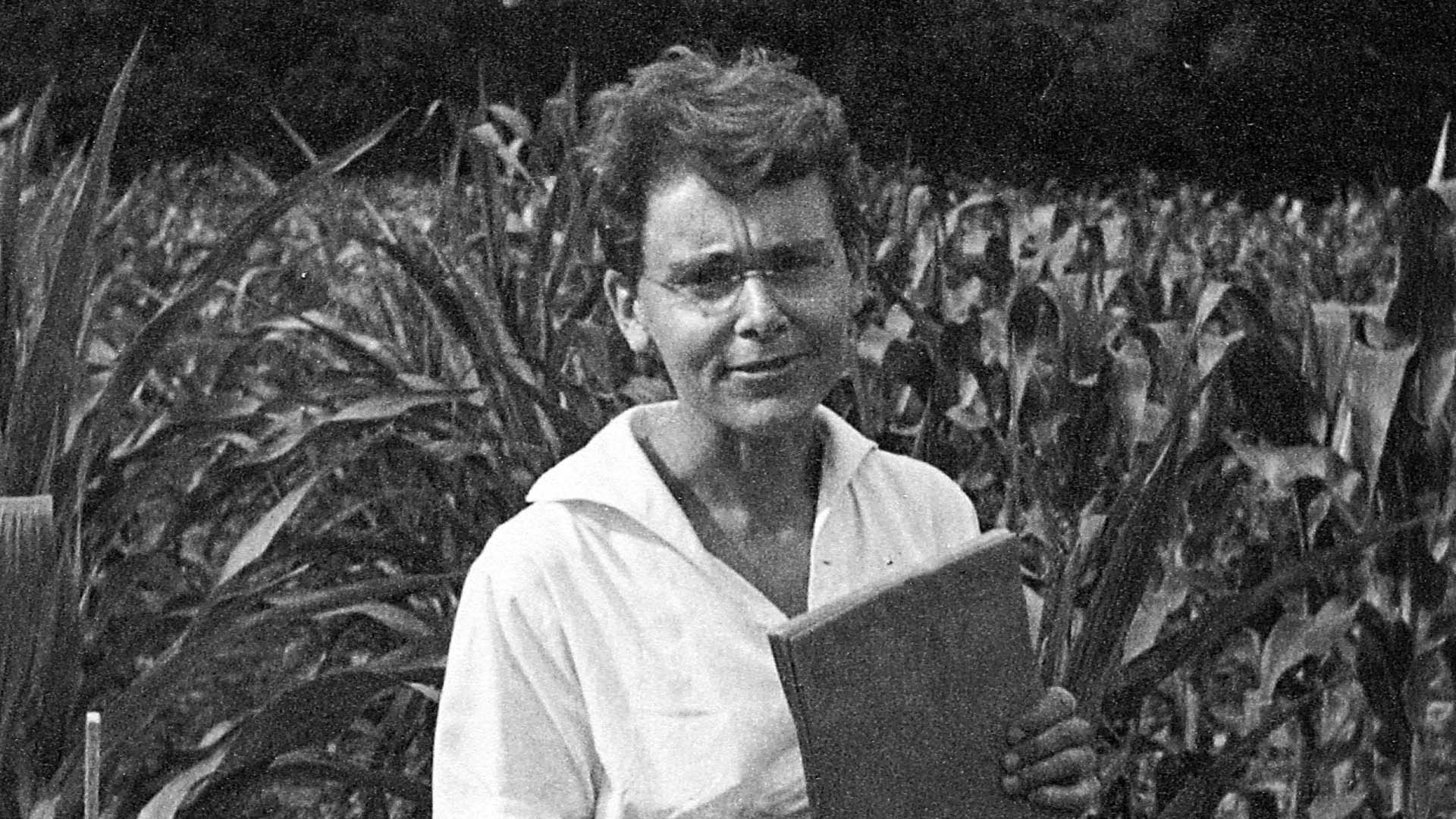Get ready to meet Barbara McClintock, a genius who changed the way we think about genetics. We’ll dive into her amazing life and discoveries, from the hidden secrets of genes to the mystery of her own personal story. And we’ll uncover why she’s known as the “golden lady of genetics.” Buckle up for the wild ride of Barbara McClintock, a pioneer whose mark on science is still being deciphered today.
Interesting Facts About Barbara McClintock
Barbara McClintock – ever heard of her? She was a total rockstar in the world of genetics! Her mind-blowing discovery about genes turned everything we thought we knew upside down. Imagine genes not staying put but actually “jumping” around! That’s what McClintock found, and it blew everyone away.
This incredible woman unearthed the secrets of these “jumping genes,” officially called transposons, and changed the way we understand how our genome works. She was obsessed with corn – not eating it, though, but studying its chromosomes. Her work on corn cytogenetics was next level. It’s like she had this superpower to peer into the microscopic world of chromosomes and figure out how they do their thing. Through her tireless efforts, she revealed just how important recombination is and the crucial role chromosomes play in gene expression. It’s no wonder she’s considered a legend in the field.
Now, you might be thinking, “Okay, she was a genius, but what’s so special about her?” Her story is one for the books. Back in the day, science was a total boys’ club. Women? Forget it! But McClintock? She didn’t let that stop her. She faced prejudice and skepticism head-on but never backed down from her passion for science.
And guess what? Her unyielding dedication paid off big time. Not only did her research become the bedrock of modern molecular genetics, but she also snagged the Nobel Prize in Physiology or Medicine in 1983. That’s right – a Nobel Prize!
But there’s something else about McClintock that’s truly inspiring. Her story isn’t just about scientific breakthroughs; it’s about defying expectations and proving that anyone with enough passion and determination can change the world. She’s a beacon of hope, a testament to the power of perseverance, and a constant source of motivation for aspiring scientists everywhere.
So, next time you’re feeling stuck or discouraged, remember Barbara McClintock. Remember her curiosity, her resilience, and her unwavering belief in herself. Her legacy reminds us that even the most groundbreaking discoveries start with a single question and a whole lot of heart.
Here’s a glimpse into the fascinating life and work of Barbara McClintock:
- Transposon Pioneer: Imagine genes playing hopscotch on a DNA strand – that’s essentially what transposons, or “jumping genes,” do. McClintock’s discovery of these mobile genetic elements totally revolutionized the field of genetics. Before her groundbreaking work, scientists believed that genes were stuck in their designated spots on chromosomes. McClintock proved them wrong! She showed that genes can actually move around, changing their position on chromosomes, and sometimes even hopping to entirely different chromosomes! This discovery was a game-changer, forcing scientists to rethink their entire understanding of how genes work and how genetic information is passed down through generations.
- Corn Whisperer: Okay, maybe not literally, but McClintock was a master of corn cytogenetics. She spent countless hours studying the intricate details of corn chromosomes, meticulously mapping their structure and behavior. Her innovative techniques allowed her to visualize and analyze chromosomal changes with unprecedented precision, paving the way for major breakthroughs in our understanding of heredity and evolution.
- Shattering the Glass Ceiling: McClintock wasn’t just a brilliant scientist; she was a trailblazer for women in STEM. In a time when science was dominated by men, she defied societal norms and carved out a space for herself in a male-dominated field. She faced prejudice and discrimination throughout her career, but she never let that dim her light or deter her from her pursuit of scientific truth. Her story is a testament to the power of perseverance and a source of inspiration for aspiring female scientists everywhere.
- Nobel Prize Winner: In 1983, McClintock’s groundbreaking discoveries were finally recognized with the highest honor in the scientific community – the Nobel Prize in Physiology or Medicine. This prestigious award solidified her place as one of the most influential scientists of the 20th century and cemented her legacy as a true pioneer in the field of genetics.
- Inspiring Future Generations: McClintock’s impact extends far beyond her groundbreaking discoveries. Her unwavering passion for science, coupled with her resilience in the face of adversity, continues to inspire generations of young scientists to pursue their own scientific dreams. She showed the world that with curiosity, determination, and a willingness to challenge conventional wisdom, anyone can make a difference in the world of science.
- A Legacy of Discovery: McClintock’s work continues to shape our understanding of genetics and evolution, making her research just as relevant today as it was decades ago. Her discoveries have had a profound impact on fields ranging from medicine to agriculture, paving the way for new treatments for genetic disorders and the development of more resilient and productive crops. Her legacy is a testament to the power of scientific inquiry and the enduring impact of one woman’s dedication to unraveling the mysteries of life.
What is Barbara McClintock fun facts?
One of the coolest things McClintock found while peering down her microscope at those corn chromosomes was that genes weren’t as stationary as everyone thought. They could actually jump around on the chromosome! Imagine the surprise in the scientific community when she dropped this bombshell discovery of “transposons,” aka “jumping genes,” back in 1948. It totally shook things up and challenged the very foundation of what everyone thought they knew about genetics.
But how did she even see these tiny chromosome gymnastics in action? Well, McClintock was a whiz at developing new techniques. She used dyes and a super-powered microscope to create colorful chromosome maps, kind of like a secret code revealing the secrets of inheritance. This groundbreaking work allowed her to watch chromosomes swap bits and pieces during reproduction, a process called recombination. This was huge! It explained how we get such awesome diversity in everything from eye color to height.
Now, imagine being a woman scientist in the early 20th century. Not exactly a walk in the park, right? McClintock faced her fair share of skepticism and even outright dismissal from some of her male counterparts. But did she let that stop her? Nope, not a chance! This woman was on a mission to unravel the mysteries of genetics, and nothing could stand in her way. Her perseverance paid off big time when she was finally recognized for her groundbreaking discoveries. It’s important to remember that science, like any field, has its share of biases. McClintock’s story serves as a powerful reminder to challenge assumptions and keep pushing boundaries, even when facing resistance.
The amazing thing about McClintock’s work is that it’s still incredibly relevant today. Scientists are constantly digging deeper into her research on transposons and discovering just how important these “jumping genes” are to things like evolution and even diseases like cancer.
The thing about science is it’s a never-ending puzzle, and McClintock’s legacy is all about approaching that puzzle with curiosity, determination, and a healthy dose of creativity. Her story is a testament to the power of challenging the status quo and never giving up on your passion, even when the going gets tough. And that’s something we can all be inspired by!
Did Barbara McClintock Have Kids?
Barbara McClintock was a woman who threw herself wholeheartedly into her work. You see, for Barbara, science wasn’t just a job, it was an all-consuming passion. This intense dedication to unraveling the mysteries of genetics meant that certain aspects of life that many consider “traditional” — like marriage and children — weren’t part of her story. It’s not that she didn’t value these things, it’s just that her heart was set on a different path, one less traveled, especially for women of her time.
And boy, did that path lead to incredible places! Her work, often done in solitude, led to some truly groundbreaking discoveries in the field of genetics. Back then, the idea of genes being fixed in place was the common belief. But Barbara, with her trusty microscope, saw something different, something revolutionary. She found these things called “jumping genes” – imagine pieces of code in a computer program suddenly shifting positions – that’s kind of what these jumping genes, or transposons as they’re formally known, were doing! This discovery turned the genetics world on its head!
Her journey wasn’t always easy though. Being a woman in a field dominated by men meant facing a lot of raised eyebrows and skepticism. People simply weren’t used to a woman challenging the scientific norms. But Barbara persevered. Her dedication to her research, her refusal to back down, eventually won everyone over. And the ultimate recognition? The Nobel Prize in Physiology or Medicine in 1983. A well-deserved award for a woman who dared to challenge the status quo and reshape our understanding of genetics.
Even today, Barbara McClintock’s story resonates. She’s a shining example of how passion, perseverance, and a willingness to break boundaries can lead to truly remarkable achievements. She showed the world that science needs all kinds of minds, and sometimes, the quietest voices can spark the biggest revolutions.
What discovery did Barbara McClintock make?
McClintock spent years studying corn – yes, the kind we eat! But she wasn’t interested in its taste; she was captivated by its chromosomes, those tiny structures inside cells that carry our genes. Imagine her surprise when she noticed that some parts of these chromosomes weren’t staying put like everyone thought they should. Instead, they were moving around, hopping from one spot to another! Talk about a scientific plot twist.
She called these mobile pieces of DNA “transposons,” but they’re often nicknamed “jumping genes.” This discovery was a HUGE deal because, back then, everyone thought genes were stuck in their designated spots on chromosomes. McClintock’s research turned this idea on its head, revealing that genomes – an organism’s complete set of DNA – are way more dynamic and exciting than anyone had imagined.
Think of it like this: if chromosomes are like a recipe book, genes are the individual recipes. McClintock found out that some recipes, the transposons, could actually cut themselves out of the book and paste themselves onto different pages! This rearranging could change how the other recipes turned out, leading to new and unexpected flavors. In the same way, transposons jumping around in our DNA can change how our genes work and even create variations in traits like eye color, height, or even susceptibility to certain diseases.
Of course, such a revolutionary idea wasn’t immediately embraced. Some scientists were skeptical at first; after all, it was a pretty radical notion for the time. But McClintock, true to her brilliant self, didn’t let that discourage her. She meticulously documented her observations, built a solid case with her research, and, eventually, the scientific community came around to recognizing the magnitude of her findings.
And boy, were her findings impactful! Her discovery of transposons opened up a whole new avenue in genetics. Now, we know that these “jumping genes” play a role in:
- Evolution: Imagine transposons shuffling genetic information over generations, leading to new traits that could make an organism better suited to its environment. Pretty neat, huh?
- Medicine: Researchers are studying how transposons might contribute to diseases like cancer, hoping to find new ways to diagnose and treat them.
- Agriculture: By understanding how transposons influence traits in plants, scientists can work towards developing more resilient and productive crops.
The more we learn about transposons, the more we realize how important they are in shaping life as we know it. McClintock’s work wasn’t just about identifying a new genetic element; it was about revealing the incredible flexibility and complexity of life’s blueprint. She taught us that genomes are not static instruction manuals, but dynamic and ever-changing narratives. Her legacy continues to inspire scientists to question assumptions and explore the mysteries hidden within our cells. Who knows what other genetic marvels are waiting to be discovered?
Does Barbara McClintock have a middle name?
So, we’ve been talking about Barbara McClintock, this amazing scientist who basically turned the field of genetics upside down. Her work on transposons, those “jumping genes,” was revolutionary. We know she was a powerhouse in the lab, but you might be surprised to learn that there’s a bit of mystery surrounding her full name. While historical records consistently refer to her as “Barbara McClintock,” there’s no widely documented evidence of her having a middle name.
Now, this doesn’t mean she didn’t have one. It’s possible that she did, and it was just never commonly used or recorded in official documents. Sometimes people choose to go by their first and last names only. It was the early 20th century, after all, and things were a bit different back then!
It’s intriguing to think about, isn’t it? This small detail reminds us that even the most famous historical figures can have little mysteries surrounding them. And while uncovering a middle name might not change our understanding of McClintock’s groundbreaking scientific contributions, it adds a touch of human curiosity to her story.
What did Barbara McClintock love?
We know about her groundbreaking discoveries, but what really got Barbara McClintock going? What fueled her passion? In a nutshell, she was head over heels for genetics. This wasn’t just a job for her; it was a lifelong fascination with the intricate dance of genes and inheritance. Imagine spending your days unraveling the secrets of life’s blueprint – that’s what she lived for.
And unravel them she did! McClintock dove deep into the world of corn, meticulously studying its chromosomes. It was in these tiny structures that genes resided, holding the instructions for everything from the color of the kernels to the height of the plant. By observing how traits were passed down through generations of corn, McClintock made a game-changing discovery: transposons, or as they’re more affectionately known, “jumping genes.”
Think of them as little snippets of DNA that can actually move around on a chromosome. It was a radical idea at the time, challenging the very foundation of how we understood genetics. Suddenly, genes weren’t fixed in their place; they could jump around, influencing other genes and leading to unexpected traits. McClintock’s findings suggested a whole new level of complexity and dynamism within our genetic makeup.
It’s important to note that the scientific community didn’t immediately embrace McClintock’s discoveries. Like many pioneers, her work was initially met with skepticism. However, as researchers delved deeper into molecular biology, the evidence supporting her findings became undeniable. The scientific world eventually caught up, recognizing the profound implications of her work.
McClintock’s dedication and groundbreaking research earned her the Nobel Prize in Physiology or Medicine in 1983. It was a well-deserved recognition of her lifelong passion for genetics and her remarkable contributions to our understanding of the building blocks of life. Even today, her work continues to shape research, reminding us that the world of genetics is full of surprises, just waiting to be uncovered.
Did Barbara McClintock Work Alone?
This scientific trailblazer wasn’t exactly surrounded by a cheering squad, especially in her early years. Imagine yourself as a brilliant scientist with groundbreaking ideas, but most of your peers just weren’t quite on the same page. That was Barbara’s reality for a good while.
While she did collaborate with some researchers throughout her career, particularly during her time at Cornell University and Cold Spring Harbor Laboratory, a significant portion of her most groundbreaking work, like her discovery of transposons (those “jumping genes”), was largely a solo endeavor.
Think about that for a second – a woman in a male-dominated field, going against the grain and challenging the established scientific norms, mostly on her own. It speaks volumes about her dedication, her sharp intellect, and her sheer determination to uncover the secrets hidden within the intricate world of genetics.
Now, does this mean she was completely isolated in her research? Not exactly. She did correspond with other scientists, sharing her findings and engaging in intellectual discussions. However, the widespread acceptance and recognition of her work, especially the revolutionary concept of transposons, took quite some time to gain traction within the scientific community.
Why the delay in recognition? Well, part of it might have been due to the complexity of her research and the fact that it challenged the prevailing dogma of the time. Remember, back then, the idea that genes weren’t fixed entities but could actually move around on chromosomes was pretty radical!
So, while Barbara McClintock might not have been physically alone in a lab, the path she forged, the intellectual risks she took, and the groundbreaking discoveries she made were, in many ways, a testament to her independent spirit and her unwavering commitment to scientific exploration. Her story is a powerful reminder that sometimes, the most profound breakthroughs come from daring to venture beyond the well-trodden paths and trusting your own scientific instincts.
Where did Barbara McClintock go to school?
Her path led her to Cornell University. It was there that McClintock, a woman who practically breathed science, really delved into the world of plants, earning her Bachelor of Science degree in 1923. You see, McClintock wasn’t content with just skimming the surface of knowledge. She dove headfirst into the intricate world of botany, laying the foundation for her groundbreaking discoveries in genetics.
Think about it: Cornell in the 1920s! It was a melting pot of ideas, and for someone as inquisitive as McClintock, it must have been like stepping into a playground for the mind. While we don’t have a detailed itinerary of her every class or late-night study session, we can imagine her soaking up knowledge from professors, challenging existing theories, and perhaps even engaging in lively debates with her peers. It was at Cornell that her passion for scientific inquiry truly blossomed, setting the stage for her to become a pioneering figure in the world of genetics.
Who Is the Golden Lady of Genetics?
That would be Barbara McClintock, a true rockstar in the world of genetics! She totally rocked the boat with her amazing discoveries, especially her work on things called “jumping genes.” They’re also known as transposons, but “jumping genes” just sounds way cooler. Because of this groundbreaking research, she nabbed the Nobel Prize in Physiology or Medicine back in 1983.
Back then, everyone thought genes were stuck in their place. But Barbara, oh no, she wasn’t afraid to shake things up! She dove deep into the world of corn, studying its genetics, and bam! She found out that genes weren’t so stuck-up after all. They could actually move around on the chromosome! Imagine that, genes hopping around like tiny explorers! This was a total game-changer. It meant that genes could turn on or off in different places, making each organism unique. Talk about shaking things up!
Of course, not everyone was ready for such a radical idea. Some folks in the scientific world back then weren’t so keen on a woman making such big waves. But did that stop Barbara? Not a chance! She was fiercely dedicated to her work. She knew what she had discovered was huge, and she wasn’t going to back down.
And guess what? Eventually, everyone else caught up. Her work on these “jumping genes” basically rewrote the genetics textbook. It’s a big deal for understanding how evolution works, how diseases happen, and even how we grow food.
So, yeah, Barbara McClintock, the “Golden Lady of Genetics,” wasn’t just a brilliant scientist; she was a rebel with a cause. She taught us to never underestimate those tiny things we can’t even see, because they might just hold the secrets to, well, everything!
Where was Barbara McClintock buried?
Barbara McClintock, the groundbreaking geneticist famous for discovering those jumping genes (transposons) sadly passed away on September 2, 1992, in Huntington, New York. But her work is still SO important to scientists today.
She’s buried over at the Cold Spring Harbor Cemetery in New York. That makes sense, right? She spent ages working at the Cold Spring Harbor Laboratory and made some seriously big discoveries there. It’s like her scientific home away from home.
Think about it:
- This amazing woman, Barbara McClintock, totally changed how we see genetics, and we still feel her impact.
- She’s resting peacefully at the Cold Spring Harbor Cemetery, a fitting place considering her incredible career.
Want to dive deeper? Check this out:
Barbara McClintock – Cold Spring Harbor Laboratory
Who discovered the jumping genes?
That would be the incredible Barbara McClintock. This pioneering scientist dove deep into the world of genetics, specifically focusing on maize (corn!). Back in 1948, she made a pretty groundbreaking discovery: these little genetic elements that could actually move around on a chromosome! Yep, you read that right – genes that jump. She called them “controlling elements,” but today we know them as transposons or, more casually, jumping genes.
The idea of genes being stable and fixed in place was pretty much the norm back then. So, when McClintock came along with her research suggesting that genes could actually be dynamic and mobile, well, let’s just say it ruffled some feathers. It was a pretty radical idea for the time.
Despite the initial pushback, McClintock was incredibly thorough in her work. Her experiments were meticulous, and she provided a ton of evidence to support her findings. It wasn’t an easy road, though. The fact that she was a woman in a very male-dominated field at the time added another layer of difficulty in getting her work recognized and accepted. But she was persistent, and eventually, the scientific community began to see the significance of her discoveries.
It’s important to remember that science is a process, and sometimes big ideas take a while to sink in. McClintock’s work was definitely groundbreaking, and it opened up a whole new way of thinking about how genes work. She showed us that genomes are far more dynamic and complex than we initially thought. It’s like realizing that the letters in a book can rearrange themselves and change the story entirely!
Her incredible contributions to the field of genetics didn’t go unnoticed. In 1983, Barbara McClintock was awarded the Nobel Prize in Physiology or Medicine. This was a huge deal – she was the first woman to receive this prestigious award unshared. Talk about breaking barriers!
Her story is a testament to the power of curiosity, perseverance, and challenging the status quo. McClintock’s legacy continues to inspire scientists today, and her work still has a major impact on fields like genetics, genomics, and even medicine.
Did you know that Edvard Munch was obsessed with sickness and death? Learn more about this and other interesting facts about interesting facts about Edvard Munch. Frederic Chopin’s heart was removed after his death and is now on display in Warsaw. Discover this and other interesting facts about Frederic Chopin. J.D. Salinger was a notoriously private person who refused to give interviews or have his picture taken. Uncover more interesting facts about J.D. Salinger.
- Crypto Quotes’ Red Flags: Avoid Costly Mistakes - June 30, 2025
- Unlock Inspirational Crypto Quotes: Future Predictions - June 30, 2025
- Famous Bitcoin Quotes: A Deep Dive into Crypto’s History - June 30, 2025

















2 thoughts on “Uncovering the Genius: Interesting Facts about Barbara McClintock”
Comments are closed.